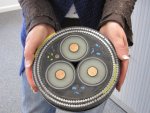I am buying some paddles for my wireless. I expect that 50' cables should do for any current needs.
What do you suggest? It should be pretty flexible so it can be coiled and stored easily and not overly bulky if possible.
Of course, I would like to pay as little as I can.
Sent from my iPad HD
What do you suggest? It should be pretty flexible so it can be coiled and stored easily and not overly bulky if possible.
Of course, I would like to pay as little as I can.
Sent from my iPad HD


